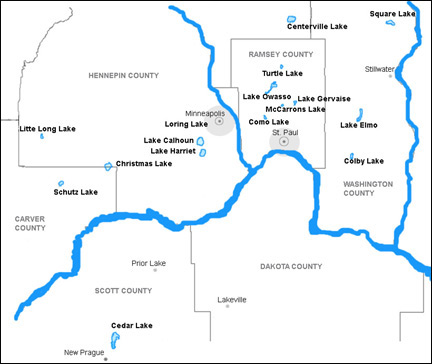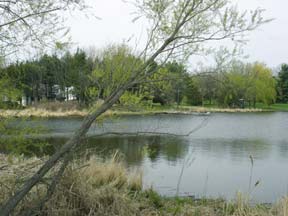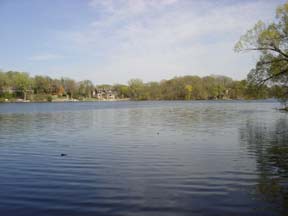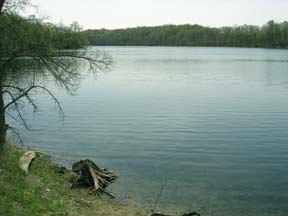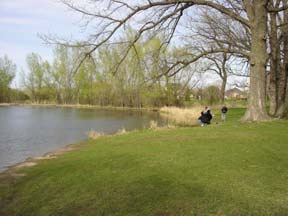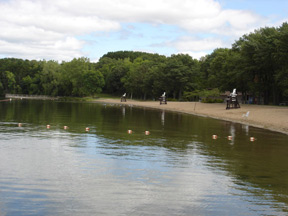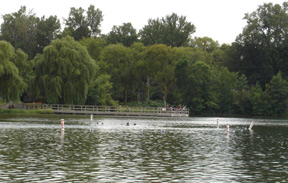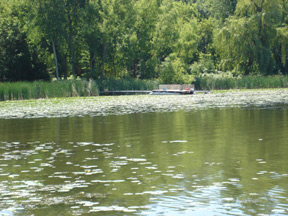M.S. Thesis project – Moriya Rufer
Introduction
In the Twin Cities Metropolitan Area (TCMA), lakes are a valuable resource for recreation, ecological habitat and the water supply system (TCMC 2003). Therefore, they are closely monitored by the Twin Cities Metropolitan Council (TCMC) in cooperation with the Minnesota Pollution Control Agency (MPCA) and the Minnesota Department of Natural Resources (MDNR). Water quality, chemistry and clarity are tested in TCMA lakes yearly (TCMC 2003). Aquatic insect communities can give a better long-term description of lake quality than the “snapshot” that water chemistry provides because of their relatively long life spans and specialized habitat requirements (Saether 1979, Ferrington et. al. 1991), but they are not used in biomonitoring programs in TCMA lakes. This could be due to the fact that traditionally, the sampling and identification process for aquatic insects is time consuming and expensive (Ferrington et. al. 1991).
Chironomidae (Diptera) are a family of small flies whose larval stage makes up over 50% of the benthic macroinvertebrate community. They are such a diverse and widespread family that they can subsist in most climates and a wide range of water qualities (Saether 1979, Coffman and Ferrington 1996). These characteristics make them excellent candidates in monitoring water for the presence of pollution and determining the lake trophic level. If chironomid communities were assessed in TCMA lakes, a more complete and comprehensive picture of water quality could be understood.
In this proposal, a more efficient technique becoming widely accepted for chironomid sampling is recommended for TCMA lakes. Traditionally, the chironomid larval stage has been used in macrobenthos studies, however chironomids are holometabolous and therefore their lifecycle also includes a pupal stage. When the pupa is fully developed, it swims to the surface and the adult emerges. The remaining pupal skin (exuviae) floats on the water’s surface for a few days and can be collected easily with a sieve. These exuviae take one-third the time to process than do larvae, and in addition they allow for better taxonomic resolution (Ferrington et. al. 1991).
Along with the increased ease in collecting and identifying chironomids, comes the opportunity to create a model of lake trophic levels using Chironomidae communities. Ole Saether (1979) developed a model for predicting Holarctic lake trophic classification by grouping holarctic chironomid species (131 in all, 88 of which are found in North America) into 15 communities representing different lake trophic conditions. Six communities were characteristic of oligotrophic lakes, three of mesotrophic lakes and six of eutrophic lakes. From this classification, he concluded that chironomid communities are distributed across a curve of total phosphorus/mean lake depth and chlorophyll a/mean lake depth (see Figure 1). This model could be refined for the TCMA lakes, and would aid local agencies and the community immensely when determining the recreational and ecological habitat qualities of lakes.
In 2002, Les Ruse used pupal exuviae to characterize the distribution of chironomids in lakes of the United Kingdom and found alkalinity and lake volume to be the most predictable measures of species communities.
My primary research objective is to determine the chironomid species in TCMA lakes and compare the results to the PCA and TCMC water chemistry measures to develop a model for predicting urban lake classification based on chironomid communities. This procedure could include revising Saether’s model for the TCMA, or developing a new model depending on which water chemistry measures fit a curve with chironomid community distribution. My secondary research objective is to compile a comprehensive list of chironomid species found in urban areas of the Upper Midwest Region and determine if there are any undescribed species present. Thirdly I will determine how many sampling dates are needed and when are the best times of the year to get a good picture of the chironomid community of urban lakes. Lastly, using pupal exuviae, I will make it easier and more affordable to do chironomid community assessments in the Twin Cities lakes by developing a key to pupal exuviae that would be useful to biologists in urban areas of this region, including the PCA and TCMC.
Methods
The lakes in the TCMA span a gradient of mesotrophic to hypereutrophic, and I have chosen four mesotrophic lakes, eight eutrophic lakes and four hypereutrophic lakes for a total of 16 lakes (see Table below). I selected lakes keeping the following variables constant to minimize complicating factors 1) they will not have a known pollutant source other than organic enrichment (i.e. heavy metals), 2) they will all have boat access, 3) 40-80% of the surroundings will be residential, 4) they will be the same hydrologic type. Now that I have my list of lakes to sample, I am in the process of contacting the lake owners associations to inform them of my study and obtain permission to access the lake from residential shores. While collecting samples, I will share my project with any interested residents of the lake to increase interest and stewardship in the area of lake water quality.
I will collect Surface Floating Pupal Exuviae (Ferrington et al. 1991) monthly from April to November 2005. The sampling will consist of 8 dates/lake x 16 lakes x 1 sample/lake/date = 128 total samples.
Finally, I will identify the pupal exuviae to the lowest resolution possible and draw them for a key that will be useful for biologists in urban areas of the Upper Midwest Region. This key would also be available on a website for use in the public community. With the creation of this key and it’s wide availability, the ease in identifying chironomids would give a much more comprehensive picture of water quality and the community can easily get involved in further monitoring of this valuable resource.
Sample Lakes
| Lake | County | Mean P | Secchi (m) | Carlson |
|---|---|---|---|---|
| Little Long | Hennepin | 11 | 5 | 39 – O |
| Square | Washington | 12 | 6.4 | 40 – O |
| Christmas | Hennepin | 13 | 5.7 | 41 – M |
| Elmo | Washington | 15 | 4.3 | 43 – M |
| Turtle | Ramsey | 25 | 2.4 | 51 – E |
| Schutz | Carver | 30 | 2.0 | 53 – E |
| Calhoun | Hennepin | 31 | 3.0 | 54 – E |
| Harriet | Hennepin | 32 | 3.2 | 54 – E |
| Gervais | Ramsey | 36 | 1.5 | 56 – E |
| Owasso | Ramsey | 41 | 2.2 | 58 – E |
| McCarron | Ramsey | 41 | 1.9 | 58 – E |
| Centerville | Anoka | 54 | 1.2 | 62 – E |
| Loring | Hennepin | 160 | 0.9 | 77 – H |
| Colby | Washington | 168 | 0.5 | N/A – H |
| Cedar | Scott | 260 | 1.4 | 84 – H |
| Como | Ramsey | 274 | 1.3 | 85 – H |
Figure 1. Sample lake locations.
Data Analysis
Using the MPCA’s measurements of total phosphorus, I will determine the epilimnetic phosphorus to mean depth ratio for each study lake. Then I will fit the TCMA lakes appropriately to Saether’s model according to phosphorus/mean depth (see Figure 1). After the Chironomidae pupal exuviae are identified to the lowest taxonomic resolution possible, I will calculate the percentage of species that match Saether’s 1979 results. Species information will be graphed against the following water quality parameters: Total phosphorus, chlorophyll a, and nitrogen. To determine how closely my model fits Sather’s, I will calculate a coefficient of similarity (a mathematical way of comparing species assemblages in different locations). This comparison will be analyzed for trends. If it does not fit the same trend as Saether’s, ecological equivalents can be determined for the Nearctic, or a whole new model specific to the TCMA will be assembled that can be used to predict the trophic level of TCMA lakes.
Preliminary references
Coffman, William P. and Leonard C. Ferrington Jr. 1996. Chironomidae, Chapter 26. Pp. 635. In: An Introduction to the Aquatic Insects of North America, Third Edition. R. W. Meritt and K. W. Cummins (eds.) Kendall/Hunt Publishing Company, Dubuque, IW. 722 pp.
Hall, Roland I., Peter R. Leavitt, Roberto Quinlan, Aruna S. Dixit, and John P. Smol. 1999. Effects of agriculture, urbanization, and climate on water quality in the northern Great Plains. Limnol. Oceanogr. 44(3, part 2) 739-756.
Heiskary, Steven and Ed Swain. 2002. Water Quality Reconstruction from Fossil Diatoms: Apllications for Trend Assessment, Model Verification, and Development of Nutrient Criteria for Lakes in Minnesota, USA. Minnesota Pollution Control Agency, Environmental Outcomes Division, St. Paul, Mn.
Ruse, Les. 2002. Chironomid pupal exuviae as indicators of lake status. Arch. Hydrobiol. 153(3): 367-390.
Saether, O. 1975. Chironomid communities as water quality indicators. Holarctic Ecology 2: 65-74.
Twin Cities Metropolitan Council (TCMC). 2003. Aquatic Resource Assessment for the Twin Cities Metropolitan Area Natural Resources Inventory and Assessment.
Wilson, R.S. 1980. Pp.209-216. In: Chironomidae Ecology, Systematics, Cytology and Physiology, D. A. Murray (ed.). Proceedings of the 7th International Symposium on Chironomidae. Pergammon Press, Dublin. 354 pp.
